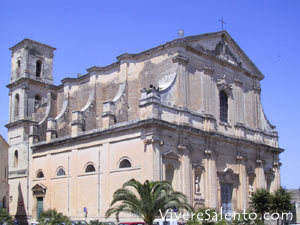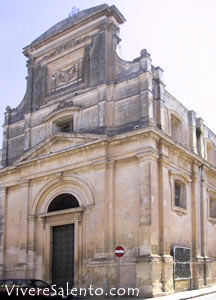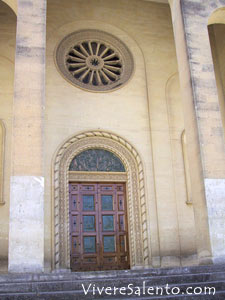|
|

One of the most ancient
noble residences is the Ducal Palace of the Marulli family, that was probably
built in
 the
XVII century on an ancient XVI century fortress. The main façade attracts
people's attention since it is imposing and richly decorated. On the two sides
of the wonderful front door there are two columns with magnificent capitals
surmounted by an elegant balcony. There are also some niches containing the
sculptures of big statues and busts. The interiors are well-decorated and the
ceilings are full of paintings. Here there used to be the Chapel of St. James
dated 1621. Now this palace has turned into the Town hall. The most important
religious monument is the Mother Church dedicated to the Madonna of the Graces.
It was built on the rests of a pre-existing XVII century building in the XIX
century. The wide façade has a simple portal and on its two sides there are two
niches containing the statues of St. Peter and St. Paul. This church with nave
and two aisles has six very beautiful baroque altars that are richly adorned, a
XVIII century silver bust of St. Cesario, a particular wooden statue of the Holy
Virgin Mary and valuable canvasses representing the Holy Family, the scene of
the Crucifixion, the Madonna and St. Joseph. The small the
XVII century on an ancient XVI century fortress. The main façade attracts
people's attention since it is imposing and richly decorated. On the two sides
of the wonderful front door there are two columns with magnificent capitals
surmounted by an elegant balcony. There are also some niches containing the
sculptures of big statues and busts. The interiors are well-decorated and the
ceilings are full of paintings. Here there used to be the Chapel of St. James
dated 1621. Now this palace has turned into the Town hall. The most important
religious monument is the Mother Church dedicated to the Madonna of the Graces.
It was built on the rests of a pre-existing XVII century building in the XIX
century. The wide façade has a simple portal and on its two sides there are two
niches containing the statues of St. Peter and St. Paul. This church with nave
and two aisles has six very beautiful baroque altars that are richly adorned, a
XVIII century silver bust of St. Cesario, a particular wooden statue of the Holy
Virgin Mary and valuable canvasses representing the Holy Family, the scene of
the Crucifixion, the Madonna and St. Joseph. The small Church of the St. Spirit dates back to the XVII century. The simplicity of the
façade mirrors that of the interiors. On the only altar you can see a wonderful
XIX century painting representing the Madonna of the Graces that was made by
Giosuè Raho. The Church of St. Elia cannot be dated but it was probably built
before the XVI century since there is a notarial deed of that period that makes
reference to it. The beautiful main entrance is well adorned and inside there
are four altars and interesting paintings representing St. Domenico, the
Nativity and the Madonna of the Consolation. What is more there is a fresco
divided in twelve parts each representing an episode of the life of this saint.
The Church of St. Rocco might have been built in the XVII century and it is very
simple. The façade is pretty linear and inside there are two altars, a statue
of the saint, a XVIII century shrine and some canvasses. The most ancient
religious monument is the Church of St. John Evangelist dating back to the end
of the XIV century. It was built according to the Romanesque style and it was
restored in 1979. The façade has a very simple front door and it is adorned
with some small arcs in the upper part. During the jobs of restoration some
sarcophaguses of the XIII century were recovered. This church is aisless and it
has only an altar. The protector of San Cesario is St. Cesario, that is
celebrated solemnly on November 7th.
Church of the St. Spirit dates back to the XVII century. The simplicity of the
façade mirrors that of the interiors. On the only altar you can see a wonderful
XIX century painting representing the Madonna of the Graces that was made by
Giosuè Raho. The Church of St. Elia cannot be dated but it was probably built
before the XVI century since there is a notarial deed of that period that makes
reference to it. The beautiful main entrance is well adorned and inside there
are four altars and interesting paintings representing St. Domenico, the
Nativity and the Madonna of the Consolation. What is more there is a fresco
divided in twelve parts each representing an episode of the life of this saint.
The Church of St. Rocco might have been built in the XVII century and it is very
simple. The façade is pretty linear and inside there are two altars, a statue
of the saint, a XVIII century shrine and some canvasses. The most ancient
religious monument is the Church of St. John Evangelist dating back to the end
of the XIV century. It was built according to the Romanesque style and it was
restored in 1979. The façade has a very simple front door and it is adorned
with some small arcs in the upper part. During the jobs of restoration some
sarcophaguses of the XIII century were recovered. This church is aisless and it
has only an altar. The protector of San Cesario is St. Cesario, that is
celebrated solemnly on November 7th.

The inhabitants of San
Cesario di Lecce have two dialectal nicknames: "ccuegghicozze" and
"mangiapasuli" that,
 literally,
mean " snails collectors" and " beans eaters". The first nickname is closely
connected to a popular story that tells that when the workers were building the
bell tower of the Mother Church they found a snail in a hole, situated at the
bottom of the construction. The head master tried to take it but he failed
because the small animal had reached the foundations quickly. As the man did
not want to be mocked by a stupid mollusc he ordered his men to demolish the
bell tower. literally,
mean " snails collectors" and " beans eaters". The first nickname is closely
connected to a popular story that tells that when the workers were building the
bell tower of the Mother Church they found a snail in a hole, situated at the
bottom of the construction. The head master tried to take it but he failed
because the small animal had reached the foundations quickly. As the man did
not want to be mocked by a stupid mollusc he ordered his men to demolish the
bell tower.
|